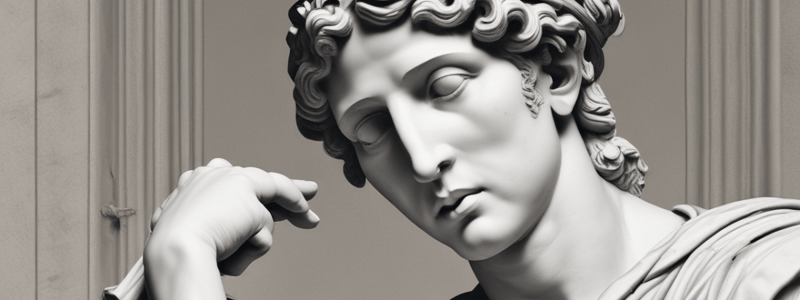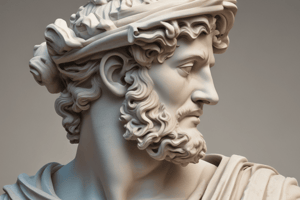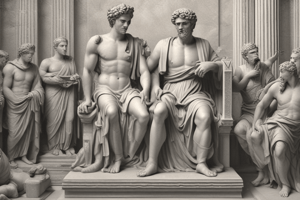Podcast
Questions and Answers
What was the main factor in choosing materials for creating mosaics?
What was the main factor in choosing materials for creating mosaics?
- The weight of the materials
- The visual effect desired (correct)
- The difficulty of working with the materials
- The cost of the materials
What was used to break down larger materials into smaller pieces for creating mosaics?
What was used to break down larger materials into smaller pieces for creating mosaics?
- Sandpaper and file
- Hammer and chisel (correct)
- Pliers and wrench
- Drill and saw
What was used to adhere the mosaic pieces to the surface?
What was used to adhere the mosaic pieces to the surface?
- Wax made from beeswax and oil
- Cement made from clay and water
- Glue made from plant resin
- Mortar made from lime and sand (correct)
What is the name of the famous mosaic depicted in Figure 7?
What is the name of the famous mosaic depicted in Figure 7?
What is the location of the Villa Romana del Casale?
What is the location of the Villa Romana del Casale?
What is depicted in the 'Bikini Girls' mosaic?
What is depicted in the 'Bikini Girls' mosaic?
What is significant about the 'Bikini Girls' mosaic?
What is significant about the 'Bikini Girls' mosaic?
What has been hypothesized about the owner of the Villa Romana del Casale?
What has been hypothesized about the owner of the Villa Romana del Casale?
What is unique about the mosaics in the Villa Romana del Casale?
What is unique about the mosaics in the Villa Romana del Casale?
What is the name of the Roman Emperor who may have owned the Villa Romana del Casale?
What is the name of the Roman Emperor who may have owned the Villa Romana del Casale?
Flashcards are hidden until you start studying
Study Notes
L'influenza dell'arte greca sull'arte romana
- The Romans admired Greek art and adopted many Greek artistic styles and techniques
- Greek architectural orders (Doric, Ionic, Corinthian) were used in Roman architecture
- Roman sculptures replicated Greek poses, drapery styles, and attention to anatomical accuracy
- Greek geometric and ornamental patterns were used in Roman mosaics and frescoes
- Greek literature and philosophy had a profound impact on Roman culture, influencing artistic themes and concepts
Architectural Orders
- Doric Order: originated in Greece, characterized by short and heavy columns with simple capitals, no base in early examples
- Ionic Order: originated in eastern Greece, characterized by slender fluted columns with more elaborate capitals and the "volute" scroll ornament
- Corinthian Order: originated in Greece, characterized by narrowest fluted columns with elaborate capitals including the acanthus leaf
- Tuscan Order: developed in Rome, characterized by a plain design, non-fluted columns, and simple capitals
- Composite Order: developed in Rome, based on the Ionic order capital with the acanthus leaves of the Corinthian
Acanthus Leaves
- Ancient Greeks used acanthus leaves sparingly, while Romans fully developed their use
- Acanthus leaves are an identifying feature of Corinthian and Composite capitals
- Romans elaborated the leaves by curling them and using them liberally for grand buildings
Historical and Political Changes in Ancient Rome
- Monarchy to Republic: Rome transitioned from a monarchy to a republic around 509 BCE, marking a shift in governance
- Expansion and Conquest: Rome expanded its territories through conquest, leading to the acquisition of territories around the Mediterranean
- Julius Caesar and the End of the Republic: Julius Caesar's rise to power marked the end of the Roman Republic and the beginning of the Roman Empire
- Roman Empire: The Roman Empire reached its height under emperors like Augustus, Trajan, and Hadrian, expanding territories, constructing infrastructure, and spreading Roman culture and law
- Decline and Fall: The Roman Empire faced internal strife, economic issues, and invasions from barbarian tribes, leading to its gradual decline and eventual fall
Comparison of Greek and Roman Temples
- Greek temples were built on hills overlooking cities, while Roman temples were built in the center of cities
- Greek temples were primarily used for religious purposes, while Roman temples served a dual purpose as places of worship and political/administrative centers
- Greek temples had a raised pedestal, steps on all sides, and columns on all sides, while Roman temples were rounded with an attached portico entrance and columns only on the portico.### Architecture
- The Parthenon is built on a raised platform with a 4:9 ratio and has steps on all sides, allowing it to be approached from all directions.
- The Pantheon is a circular building with a portico entrance and is largely at street level with few steps.
- The Parthenon has columns on all sides, while the Pantheon has columns only on the portico.
Materials
- The primary materials used in the Parthenon are limestone and marble with some use of iron for strength.
- The Romans perfected the recipe for concrete and used it extensively in the Pantheon, along with brick and marble.
Columns
- The Parthenon is built with simple Doric columns.
- Roman temples, like the Pantheon, often used the Corinthian order and featured fluted columns that were engaged, meaning they were partly built into the structure.
Roofs
- Greek temples typically had pitched roofs covered with terracotta tiles or marble slabs, with sculptures on the pediments.
- Roman temples had a variety of roofing styles, including pitched roofs and barrel vaults, and sometimes used concrete and brick construction.
General Characteristics
- Greek temples were simpler and purer in design and structure, constructed in the post-and-lintel way.
- Roman temples were more decorative and adorned with sculptures, reliefs, and intricate detailing, often featuring engaged columns and pilasters.
Sculpture
- Greek statues often depicted gods, goddesses, and heroes, while Roman statues more frequently depicted historical figures, emperors, and prominent citizens.
- Greek statues typically emphasized idealized forms, with a focus on the perfect proportions of the human body.
- Roman statues often emphasized realism and individuality, portraying the subject with unique features and expressions.
- Greek statues frequently featured flowing, transparent drapery, while Roman statues often featured heavy, voluminous drapery.
Mosaics
- Mosaics are pictures or patterns produced by arranging together small colored pieces of hard material, such as stone, tile, or glass.
- Roman mosaics typically feature animal sacrifices, domestic scenes, or geometric patterns, while Christian imagery also appears on some Roman mosaics.
- Floor mosaics were often more abstract than wall mosaics and seldom contained representations of gods.
- Ancient mosaic artists used a variety of materials, including stone, ceramic, glass, shells, and precious metals, and created an adhesive mixture to adhere the tesserae to the substrate.### The Roman Villa Owner
- The identity of the villa owner has been debated by scholars, with various hypotheses proposed
- Some believe the owner may have been an imperial figure, possibly Maxentius, based on military insignia and mosaic dating
The "Bikini Girls" Mosaic
- The mosaic depicts young women engaging in athletic activities, wearing early forms of bikinis
- This artwork has sparked interest due to its representation of ancient Roman fashion and female sports
- The mosaic is located in Piazza Armerina, Sicily
Other Examples of Roman Mosaics
- Pompeii and Herculeum, Campania
- Santa Costanza, Rome
- Paestum, Salerno, Campania (Greek Temples and Ruins)
- Valley of the Temples, Agrigento, Sicily
- Velia Archaeological Site, Campania
- Greek Theater, Syracuse, Sicily
- Amphitheatre (Greek with Roman additions), Taormina, Sicily
- The Roman Forum and Colosseum, Rome (Roman Temples and Ruins)
- Ostia Antica, Ostia
- Pompeii and Herculeum, Campania
Studying That Suits You
Use AI to generate personalized quizzes and flashcards to suit your learning preferences.




